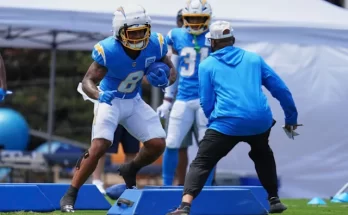Tennessee Faces Offensive Identity Crisis Heading Into 2025 Season After Losing Dylan Sampson, Star Receivers, and Core Linemen
As the 2025 college football season looms, the Tennessee Volunteers find themselves standing at a precarious crossroads—one lined with expectation, pressure, and uncertainty. The Volunteers are coming off a period of revitalization in which they clawed their way back into national conversations, restored belief among their passionate fanbase, and showed glimpses of a program on the rise. But just as momentum seemed to be building toward a potentially dominant run in the SEC, Tennessee’s offensive core has been dealt a devastating blow. The loss of star running back Dylan Sampson, several key receivers, and four starting offensive linemen has thrown the program’s trajectory into question. As fall camp draws near, the Vols are searching for not only answers but an identity on a side of the ball that once fueled their resurgence.
Dylan Sampson’s departure alone is seismic. The dynamic back had become the heartbeat of Tennessee’s offense, a home-run threat every time he touched the ball. With rare burst, vision, and balance, Sampson was a nightmare for opposing defenses and a safety valve for Tennessee’s quarterback room. His presence allowed the Volunteers to control tempo, extend drives, and break games wide open. He wasn’t just a playmaker—he was a tone-setter. Losing him removes a major piece of what made Tennessee’s offense tick, and there’s no clear successor waiting in the wings with the same explosiveness or experience.
Compounding the situation is the exodus of key receivers, a group that had developed strong chemistry and timing within the offensive system. These weren’t just possession guys; they were vertical threats, red zone targets, and dependable chain-movers. The timing couldn’t be worse. With Tennessee already breaking in a less experienced quarterback and looking to develop rhythm early in the season, having a veteran receiving corps would have been invaluable. Instead, the Vols are now counting on unproven talent to step into high-pressure roles, hoping that recruiting wins and offseason development translate quickly on the field.
And then there’s the offensive line—a unit that rarely gets the spotlight but often holds the fate of an entire offense in its hands. Tennessee is losing four starting linemen from last season, an attrition rate that would cripple even the most stable programs. Continuity up front is vital in college football, especially in the SEC, where defenses are fast, physical, and relentless. The loss of four starters means that Tennessee will enter 2025 with a largely rebuilt front five, tasked with protecting a new quarterback, creating lanes for a retooled backfield, and keeping the offense from falling into chaos. Chemistry, communication, and trust—all elements that take time to build—will have to be forged on the fly.
This trifecta of losses—Sampson, the receivers, and the linemen—has created what some insiders are calling an offensive identity crisis. Who will Tennessee be offensively in 2025? Can the Volunteers stick to their uptempo, spread-the-field attack without the explosive players who made it work? Or will they be forced to adapt, recalibrate, and become something new entirely? These aren’t small questions, and they won’t be answered in spring practice or on paper. They’ll be answered under the lights, in the roar of Neyland Stadium, and in the grind of SEC Saturdays.
There’s no sugarcoating it—Tennessee is entering 2025 with more questions than answers on offense. But in college football, adversity often brings opportunity. There’s a chance here, albeit a daunting one, for young players to rise, for hidden talents to emerge, and for a new generation of Volunteers to step into the spotlight. Tennessee’s coaching staff will be tested not just on play calling but on development, adaptability, and leadership. They’ll need to find ways to manufacture offense, simplify concepts for new starters, and get the most out of a roster that is talented but largely unproven in key areas.
Recruiting will be under the microscope. The 2023 and 2024 classes were touted as strong, but now it’s time for those players to deliver. Skill position athletes brought in with promise must now turn that potential into production. Offensive linemen who were groomed behind the scenes must become anchors. The quarterback—whoever wins the job—will need to not only manage the offense but elevate it. There will be no time for a long learning curve. Tennessee’s early-season slate includes tough tests, and any lingering weaknesses will be exposed quickly.
The psychological side of this reset can’t be ignored either. Last season, Tennessee had swagger. They knew who they were. That confidence led to big moments and big wins. But confidence is fragile when leaders depart. Who steps up in the huddle? Who delivers the speech before the game? Who makes the clutch play when everything’s on the line? Those are leadership voids that matter as much as yards and touchdowns. Tennessee must rebuild not just its depth chart, but its sense of identity and belief.
There are, of course, reasons for cautious optimism. Tennessee’s coaching staff has proven they can innovate. They’ve adapted before and found ways to maximize the talent at their disposal. There’s depth on the roster, even if it’s inexperienced. And the program’s culture—a commitment to competition, toughness, and preparation—remains strong. But make no mistake, 2025 will be a grind. There’s no hiding from what’s been lost. Success will hinge on how quickly Tennessee can stabilize its offensive unit and whether new stars can rise to fill the void left behind.
The fan base, as always, will play a critical role. Tennessee fans are famously passionate and deeply invested. They will fill Neyland Stadium regardless of who’s on the field, but they’re also keenly aware of what a successful offense looks like. Patience may be tested, and expectations will fluctuate week to week. If early struggles occur, the pressure will mount—on the quarterback, on the offensive coordinator, on the line, and on the entire coaching staff. How this team handles that pressure will go a long way in determining whether the 2025 campaign becomes a rebuilding year or a resurgent one.
One of the most pressing challenges will be the quarterback situation. Without a seasoned offensive line or reliable veteran receivers, the quarterback is being asked to do more with less. Will the offense lean on shorter passes and quick reads to keep pressure at bay? Will Tennessee rely more heavily on the ground game, even without Sampson? And what happens if the offense sputters early in the year? These are questions that will define the trajectory of the entire season.
Defensively, the Volunteers have reason to be confident, and that could help carry the team through rough offensive stretches. A strong defense can buy time for the offense to gel, keep games within reach, and give the team a fighting chance even when points are hard to come by. Special teams, too, will take on heightened importance. Hidden yardage, field position, and momentum swings will mean even more when the offense is searching for rhythm.
What’s clear is that Tennessee is entering a season unlike any in recent memory. The offensive rebuild isn’t just a transition—it’s a reinvention. Every practice, every scrimmage, every snap in fall camp will be crucial. It’s a chance for new names to write their own legacy, for coaches to showcase their development chops, and for the program to prove it can weather adversity without losing momentum. The 2025 season won’t be easy, but it will be revealing. It will show whether Tennessee is truly built to last or if their recent resurgence was more fleeting than foundational.
As kickoff approaches, fans and analysts alike will be watching closely—not just to see who wins and loses, but to see how Tennessee evolves. Because in the SEC, where the margin for error is razor thin and every game is a war, surviving turnover isn’t enough. You have to adapt, reload, and come back stronger. And for Tennessee, the challenge is clear: rebuild the offense, rediscover their identity, and prove that the future is still bright on Rocky Top, even when the stars of yesterday are gone.



